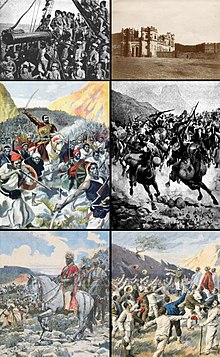First Italo-Ethiopian War
1895-1896 war between the Ethiopian Empire and the Kingdom of Italy
The First Italo-Ethiopian War[10] was a conflict between the Ethiopian Empire and the Kingdom of Italy during the Scramble for Africa from 1895 to 1896, initiated by the disputed Treaty of Wuchale where the Italians tried to convert Ethiopia into an Italian Protectorate.
| First Italo-Ethiopian War | |||||||||
|---|---|---|---|---|---|---|---|---|---|
| Part of the Scramble for Africa | |||||||||
 Clockwise from top left: Italian soldiers en route to Massawa; castle of Yohannes IV at Mek'ele;[6] Ethiopian cavalry at the Battle of Adwa; Italian prisoners are freed following the end of hostilities; Menelik II at Adwa; Ras Makonnen leading Ethiopian troops in the Battle of Amba Alagi | |||||||||
| |||||||||
| Belligerents | |||||||||
|
Supported by: | |||||||||
| Commanders and leaders | |||||||||
|
|
| ||||||||
| Strength | |||||||||
| 18,000[7]–25,000 |
196,000
| ||||||||
| Casualties and losses | |||||||||
|
18,000 casualties: 7,500 Italians dead[9] 7,100 Eritreans dead[9] 1,428 Italians wounded[9] 1,865 Italians captured[9] |
17,000 casualties: 7,000 dead[9] 10,000 wounded[9] | ||||||||

The Italians would invade Ethiopia from Eritrea[11] until they would be besieged by the Ethiopian forces in the Fort of Mek'ele, finally the Italians would sign the Treaty of Addis Ababa where the conflict would end where the sovereignty of Ethiopia would be recognized, this would bring years later the consequence of the Second Italo-Ethiopian War, which occurred between 1935 and 1936.[12]
References
change- ↑ "The activities of the officer the Kuban Cossack army N. S. Leontjev in the Italian-Ethiopic war in 1895–1896". Archived from the original on 2014-10-28. Retrieved 2022-04-14.
- ↑ Richard, Pankhurst. "Ethiopia's Historic Quest for Medicine, 6". The Pankhurst History Library. Archived from the original on 2011-10-03.
- ↑ Patman 2009, pp. 27–30
- ↑ "Soviet Appeasement, Collective Security, and the Italo-Ethiopian war of 1935 and 1936". libcom.org.
- ↑ Thomas Wilson, Edward (1974). Russia and Black Africa Before World War II. New York. pp. 57–58.
{{cite book}}: CS1 maint: location missing publisher (link) - ↑ "Ethiopian Treasures". ethiopiantreasures.co.uk. Archived from the original on 29 September 2015. Retrieved 3 October 2015.
- ↑ Vandervort 1998, p. 160
- ↑ Pankhurst 2001, p. 190
- ↑ 9.0 9.1 9.2 9.3 9.4 9.5 Milkias, Paulos (2005). "The Battle of Adwa: The Historic Victory of Ethiopia over European Colonialism". In Paulos Milkias; Getachew Metaferia (eds.). The Battle of Adwa: Reflections on Ethiopia's Historic Victory Against European Colonialism. p. 71. ISBN 978-0-87586-414-3.
- ↑ "5 Fascinating Battles of the African Colonial Era". Encyclopaedia Britannica. Retrieved 14 June 2020.
- ↑ "Photo of some of the Eritrean Ascari mutilated".
- ↑ Professor Kinfe Abraham, "The Impact of the Adowa Victory on The Pan-African and Pan-Black Anti-Colonial Struggle," Address delivered to The Institute of Ethiopian Studies, Addis Ababa University, 8 February 2006
- ↑ According to Richard Pankhurst, the Ethiopians were armed with approximately 100,000 rifles of which about half were "fast firing".[8]
Other websites
change- Berkeley, George (1969). Reprint (ed.). The campaign of Adowa and the rise of Menelik. Negro University Press. ISBN 978-1-56902-009-8.
- Clodfelter, Micheal (2017). Warfare and Armed Conflicts: A Statistical Encyclopedia of Casualty and Other Figures, 1492–2015 (4th ed.). McFarland & Company. ISBN 978-0-7864-7470-7.
- Marcus, Harold G. (1995). The Life and Times of Menelik II: Ethiopia 1844–1913. Red Sea Press. ISBN 978-1-56902-010-4.
- Vandervort, Bruce (1998). Wars of Imperial Conquest in Africa, 1830–1914. Indiana University Press. ISBN 978-0-253-33383-4.